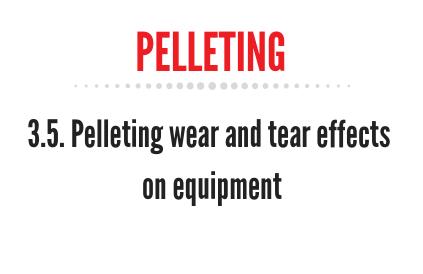Pelleting wear and tear effects on equipment

Feed components of a relatively high ash content or a high fiber content mean higher wear and tear than high-fat mixtures.
What is true for factors influencing feed pressing or "pelletability" applies by the same degree to the effects of wear in material pressing, because a higher resistance to friction also increases the probability of wear. So, the higher the amount of mechanical energy supplies into the feed, the higher of wear.
Conversely, high-fat mixtures do not allow extremely high energy inputs-there is too much lubrication.
For the pelleting or pressing process, general empirical values indicate costs for wear and tear (not including labour and downtime) in the amount of about 5% of pressing costs. That is, they would come to about 1.5% of overall costs.
These costs would be reduced by high-intensity conditioning processes, although the wear involved with super conditioners or expanders also would have to be considered.
Wear and tear or friction-related chemical reactions are more likely at downtime, for example during the weekend, rather than during processing. Such reactions are primarily determined by the affinity between the components in the feed mixtures and the construction materials used or their surface finish. Hence, it is advisable to clean the equipment prior to downtime.
Relatively high concentrations of propionic acid or formic acid, for instance, 5% for salmonella control, can produce considerable wear in the entire system when allowed to act on the equipment for prolonged periods of time. In particular, hard or hard-faced materials can be more prone to wear than other tough materials.